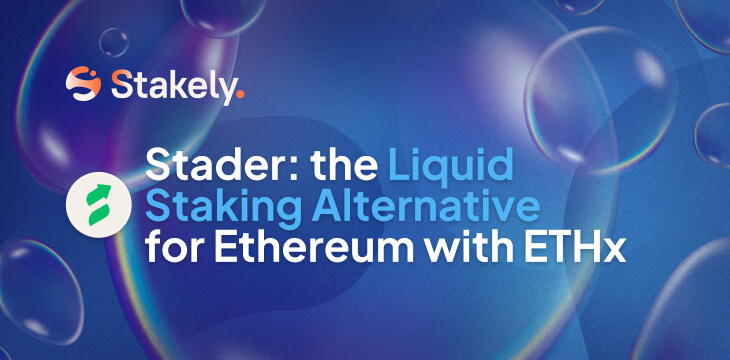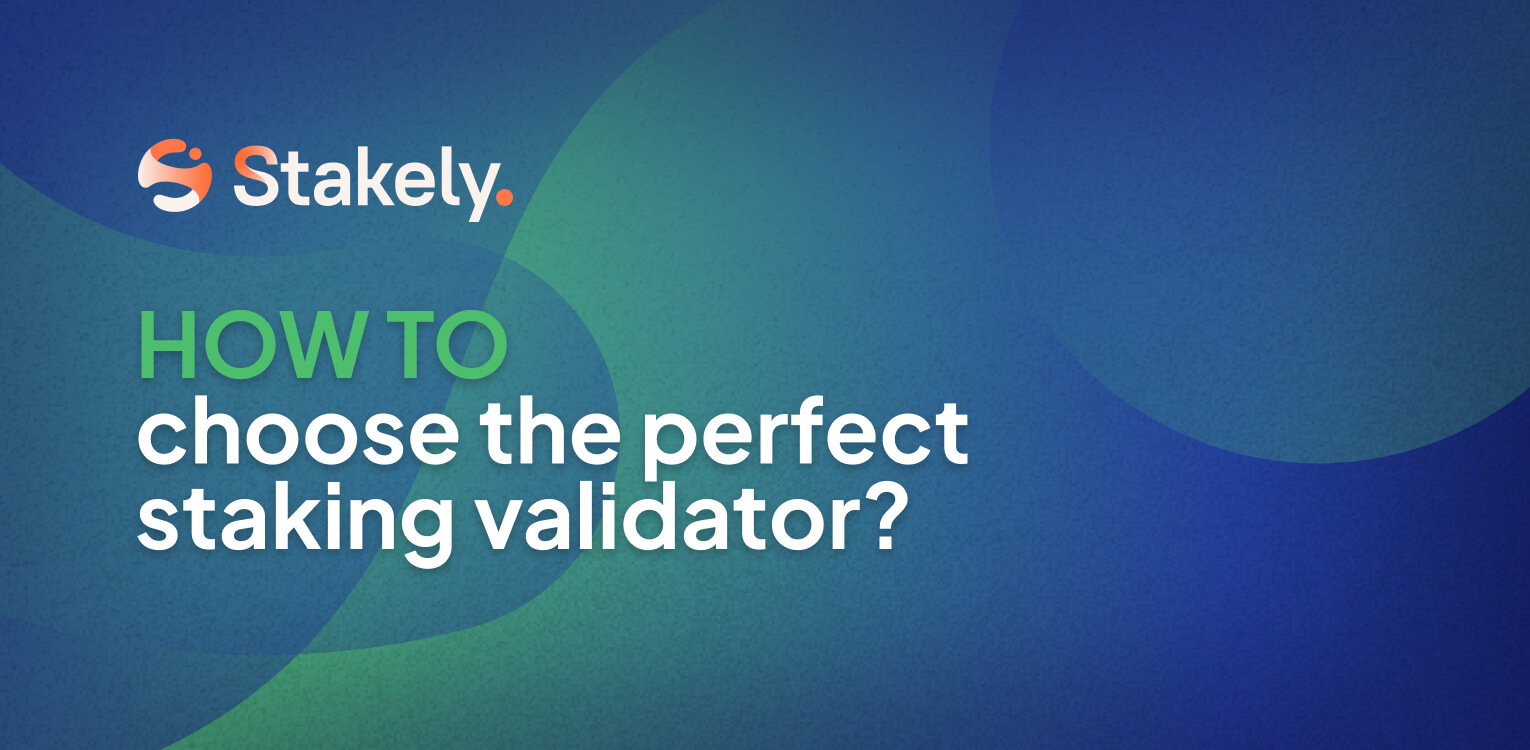What is staking and how does it work? Discover the potential of staking with Stakely

Staking is the mechanism used by Proof-of-Stake (PoS) blockchains to validate transactions, secure the network, and issue new tokens. Instead of consuming energy through mining, users lock (stake) their coins with a professional validator like Stakely and, in return, receive periodic rewards.
In this article, we’ll explain how staking works, its advantages, rewards, and risks, and why Stakely is one of the best options to stake your tokens safely and efficiently.
What is cryptocurrency staking in blockchain?
Staking is to Proof‑of‑Stake what mining is to Proof‑of‑Work: the mechanism used to secure the network and issue new coins. Instead of competing with computing power, participants lock (stake) their tokens. Although the selection is random, the larger your stake, the higher the chance of becoming a validator and signing the next block.
In return, the network periodically rewards you with more coins of that cryptocurrency. Essentially, it’s a way to earn passive income by holding your crypto assets long-term, similar to earning interest in a savings account — but while helping run the blockchain.
This practice is popular among both individual and institutional investors because it allows them to earn passive income simply by keeping their assets in staking.
Learn how staking works step by step
To participate in staking, a user stakes their tokens to a validator. The key concept is that tokens always remain in the user’s wallet; what changes is the state of those funds: they go from being freely available to being locked as collateral. The validator uses this collective backing to be selected and create new blocks.
When the validator generates a valid block, they receive rewards, which come from newly issued tokens (programmed inflation) and transaction fees. These rewards are automatically distributed among all stakers, after deducting the commission agreed with the operator.
If the user decides to withdraw their stake, they initiate a period called unbonding, during which the tokens are locked and cannot be used. Once this period ends, the tokens return to the user’s regular balance, ready for any other operation.
Types of staking
There are several ways to stake depending on your experience and the amount of crypto you hold:
- Solo staking: you run and manage your own validator node. It offers full control but requires technical knowledge and carries slashing risk if the node goes down or signs incorrectly.
- Staking pools: multiple holders pool their tokens to meet the minimum staking requirement and share rewards proportionally. Ideal when the minimum amount to stake is high.
- Exchange staking: this seemingly simple option involves the platform holding custody of your funds. In the end, users give up control over their assets in exchange for convenience.
- Staked staking: the user keeps custody of their tokens and stake the validation task to a third party. At Stakely, since it’s a non-custodial service, your tokens always remain under your control.
Advantages of staking
Staking offers many advantages both for the user staking tokens and the network the validator supports. Here are four of the main general benefits of staking:
- It’s accessible to all users, since there’s no need for expensive hardware dedicated to mining in order to participate in the network’s consensus.
- It helps save energy and is less harmful to the environment; users don’t need to consume large amounts of electricity, which leads to higher profits and a cleaner ecosystem.
- It allows greater scalability on the network where it’s implemented. The more nodes validating for the network, the greater its decentralization.
- Users receive ongoing rewards for the amount of tokens they have staked. It’s the perfect way to earn yield from assets you plan to hold. Nodes receive a small commission from these rewards to maintain the infrastructure.
By staking with Stakely, you also get additional staking benefits, including coverage from our innovative Staking Insurance program.
Staking risks and how to mitigate them
Before staking, it’s key to fully understand the project. Don’t blindly trust third parties — do your own research to make safe decisions.
| Risk | Description | Mitigation |
|---|---|---|
| Price volatility | If the token drops in value, APR may not cover the loss | Diversify and plan long-term |
| Slashing | Penalty for downtime or malicious behavior | Stake to validators with strong track records and staking insurance |
| Unbonding period | Tokens locked for days/weeks with no liquidity | Consider LSTs or plan liquidity needs |
| Centralization | Few validators concentrate too much power | Stake to mid-sized operators committed to decentralization |
For a full breakdown, check out our article analyzing the main staking risks.
How to choose a reliable validator for staking
Among the many tips we can give you for choosing a validator, the most important is to pick one that suits your needs. Avoid centralized platforms with custodial staking, where you lose control of your tokens and face higher fees. Instead, consider staking to a validator that:
- Is outside the Top 20 to avoid centralization.
- Offers support and has an active community.
- Provides staking insurance.
At Stakely we offer non-custodial staking. Plus, we provide:
- Robust and secure infrastructure: operational since 2020, having participated in over 100 mainnets and testnets.
- International certifications: ISO 27001 and SOC 2 Type II audit.
- Staking Insurance included for greater protection.
- 24/7 monitoring with real-time alerts and immediate response.
- Human technical support, direct and available 24/7.
- Full flexibility to adapt to your needs as a stakers or institution.
- Educational guides and expert guidance for stakers of all levels.
FAQs: Frequently Asked Questions About Staking
Where do staking rewards come from?
They come from programmed inflation and transaction fees included in validated blocks.
Can I withdraw my funds at any time?
It depends on the network. Many PoS blockchains require an unbonding period that can last days or weeks, during which you can’t move or use your tokens.
Can I use my tokens while they’re in staking?
Not in traditional staking, but with liquid staking you receive a derivative token you can use in DeFi without losing rewards.
How are staking rewards calculated?
They depend on various factors: the amount staked, staking duration, validator commission, protocol inflation, and network participation.
When do I start receiving rewards?
It varies by network. On some, rewards arrive within a few hours; on others, they may take several days after your initial stake.
Is there a risk of losing my tokens?
Your tokens remain in your wallet; the main risk is validator slashing, but with Stakely you’re covered by our staking insurance.
Still have questions?
Ask us directly on our Telegram. We’ll be happy to help.
Conclusion
Staking is the most accessible gateway to earning passive returns in the crypto ecosystem. By staking to an experienced validator like Stakely, you maintain custody of your assets while benefiting from robust, secure infrastructure committed to decentralization.
Ready to get started? Explore our supported networks, compare APRs, and join the more than 60,000 stakers already trusting Stakely.





